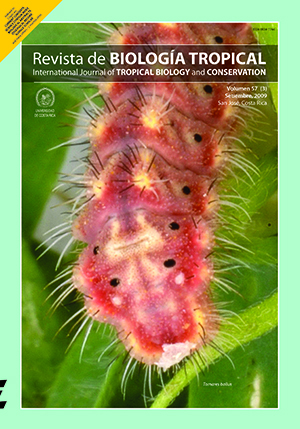Abstract
On the basis of fishery intensity and proximity to river mouth, a total of 257 swimming Callinectes crabs were collected from March 2007 to April 2008 in eight localities. Captures were made with hanging nets, to a maximal depth of 1.5m, establishing a top time of 2 hr. The genus was widely distributed, and it is represented at least by four species: C. sapidus, C. similis, C. rathbunae and C. larvatus, the lasttwo not included in the last list of Cuban crustaceans (Crustacea: Decapoda). The size and shape of the gonopods were very useful as taxonomical criteria, considering the prevalence of males. The most abundant species were C. sapidus (47.08%), and C. similis (30.35%). C. rathbunae,which wasidentified at 75% (6) of the localities, showed a better distribu-tion, followed by C. sapidus, which appears in the 63% (5). Sex rate (Rs) by species (male:female) was 6.20 for C. rathbunae, 3.58 for C. similis, 1.40 for C. larvatus and 0.40 for C. sapidus. The most abundant species had a lower Rs value. Morphometrical analysis and weight allowed us to know the average carapace width (CW) and weight (W). C. sapidus had an average CW = 110.57 mm (DS 21.55, n = 121) and W = 84.46 g (SD 43.25, n = 121); C. rathbunae a CW = 115.50 mm (DS 14.94, n = 36) and W = 140.44 g (DS 55.02, n = 36); C. larvatusa CW = 76.04 mm (DS 10.88, n = 22) and W = 31.70 g (DS 14.67, n = 22); and C. similis had the minimal parameter values, with a CW = 59.77 mm (DS 14.09, n = 78) and W = 13.80g (DS 10.00, n = 78). These are the first records of the coastal crabs in the area. All values are lower than in previous reports. The largest indi-viduals (CW>140 mm: C. rathbunae and C. sapidus) were captured in localities with adequate environmental characteristics. The stomach content suggests nine dietary categories, mainly fishes and macroalgae. The genus Callinectes has a diversified trophic spectrum. These crabs eat the available food, but they have a preference for the most abundant items.
##plugins.facebook.comentarios##

This work is licensed under a Creative Commons Attribution 4.0 International License.
Copyright (c) 2009 Revista de Biología Tropical






